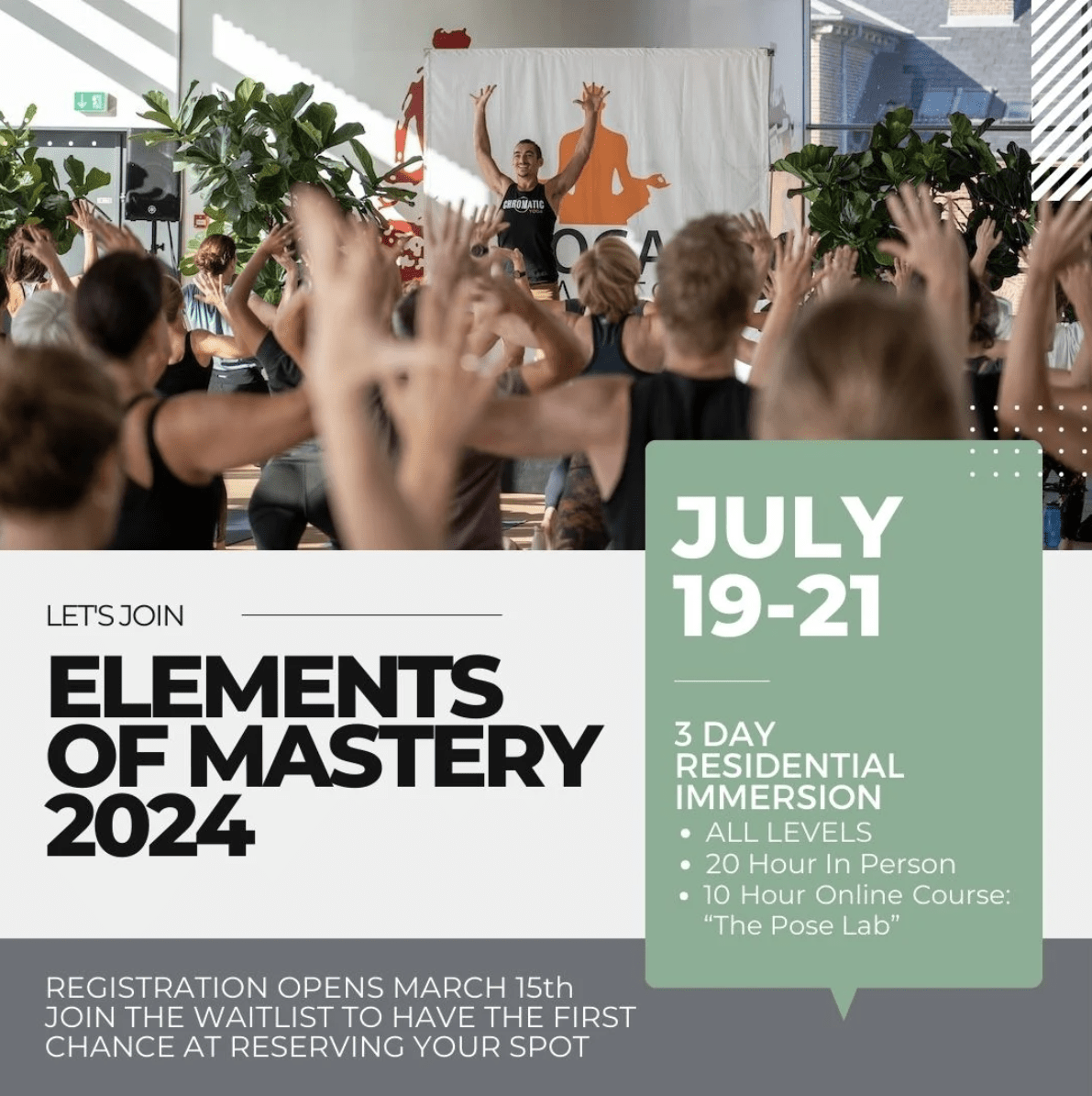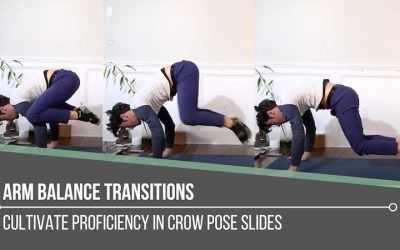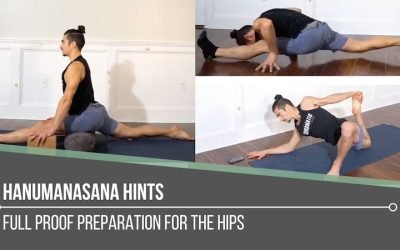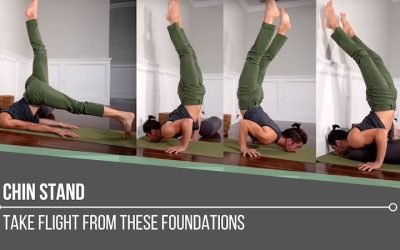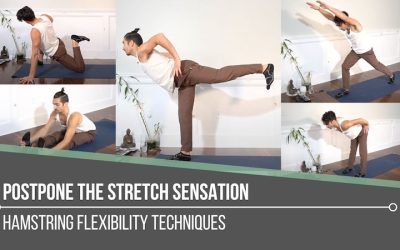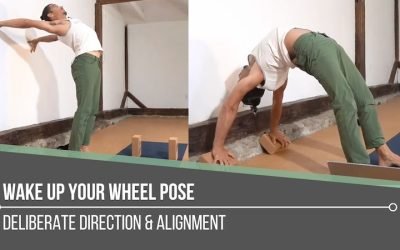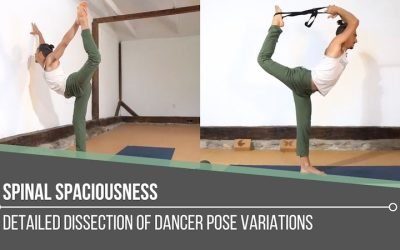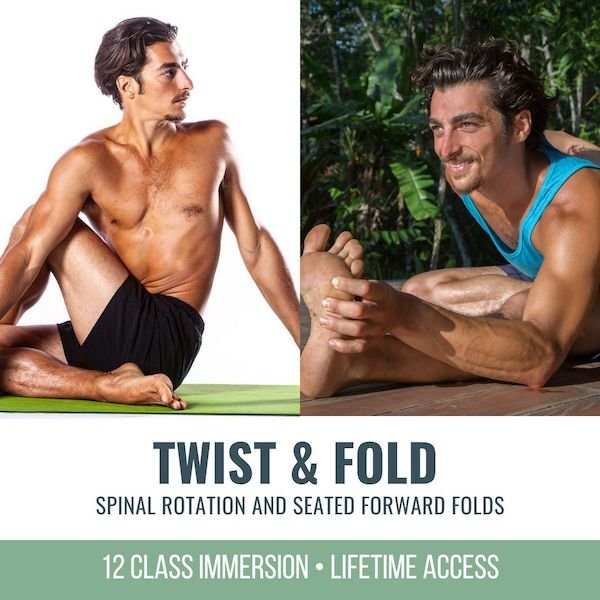Arm Balance TransitionskakasanaARM BALANCE TRANSITIONS Arm balance postures can be challenging enough without attempting to layer on a smooth transition in and out of them. However, fluid transitions are a natural progression in our yoga practice; they also provide...
Tweak The Twists In Your Yoga Practice
Tweak the Twists in Your Yoga Practice
padmasana
TWEAK THE TWISTS IN YOUR YOGA PRACTICE
The definition of “tweak” here is the following: to improve (a mechanism or system) by making fine adjustments to it.
This perfectly describes a major part of what’s involved in the school of Chromatic yoga—it’s the fine adjustments related to the biomechanics of each posture that create a massive impact and transformative experience in our yoga practice. When we pay attention to each adjustment and learn to integrate it in a way that develops our intentions with a particular posture, we reap the benefits of expanding our potential. In Chromatic yoga, Matt shows us how to sequence yoga practices in a way that integrates knowledge of anatomy, biomechanics, and technique.
The postures and drills in today’s video show us how to properly co-activate the right muscle groups in order to maximize the benefits of twists through what Matt calls the “fire line.”
ELEMENTS OF MASTERY 2024
REGISTRATION NOW OPEN
- 20 hours in person with Matt, July 19–21
- 10-hour online course “The Pose Factory” opens June 1
- Group lunch included each day
- Revolutionize your yoga practice
- Apply the Elemental and Chakra systems to your poses
- Gain mastery in your movement
- Debunk dogmatic “alignment” myths
- Learn anatomy-informed Chromatic Technique
- Hotel and spa: amazing pool area
- Optional spa treatments
- Beautiful hiking trails
- Outstanding restaurants
- Sauna and hot tub
WHAT IS THE FIRE LINE?
There are 5 elements in yoga philosophy. Referred to as mahabhutas, they are the following:
- Earth
- Water
- Fire
- Air
- Space
Each element carries its own unique qualities, which go beyond the physical. Our focus today is on the element of Fire in a physical sense, but we can see how the qualities also lend themselves to our mental and spiritual development. Here are some of the qualities that represent Fire:
- Transformation
- Motivation
- Power
- Energy
- Presence
When it comes to the physical, Matt has developed a system that allows us to coordinate specific actions within specific muscle groups at the right time. The “fire line” refers to the coactivation of the “diagonal core line.” It creates a domino effect with these steps:
- Protraction of the scapulae (activating serratus anterior)
- Spinal flexion, then layering on spinal rotation (igniting the external obliques on one side and the internal obliques on the opposite side)
- Flexion of the opposite hip (iliopsoas)
WATCH THE VIDEO
TWEAK THE TWISTS IN YOUR YOGA PRACTICE: CHROMATIC YOGA FIRE LINE EXPLAINED
CREATE THE CONNECTION
When it comes to twists in our yoga practice, it may sometimes feel easy to default to a more “relaxed” approach. What we learn from today’s video is the importance of timing and the coactivation of specific muscles that support strengthening the core for better twists. In the fire line, it’s all about cultivating power and front-body strength in the midline.
In order to begin understanding how to create the connection between twists and the appropriate muscles, we first see the following postures in the video:
- Revolved Crescent Lunge
- Revolved Crescent Lunge with Open Arms
- 2 variations of Revolved Chair
We start by creating connections through the actions of protracting the scapulae, spinal flexion, and rotation—the ability to move the upper body as a unit, rather than just moving or reaching with our arms.
200 HOUR ONLINE TEACHER TRAINING
GET CERTIFIED & DEEPEN YOUR YOGA PRACTICE
- Deepen your yoga practice
- Build confidence speaking in front of groups in person and online
- Learn foundational class structures and templates
- Learn techniques for a wide range of yoga postures
- Get certified and highly qualified to teach yoga
- Yoga Alliance Globally Recognized Certification Program
DEVELOP THE TWIST TECHNIQUE
How do we further develop the technique for twists? Well, in the video, when Matt demonstrates Revolved Low Lunge, he emphasizes “flexing” our way down, rather than just falling with gravity. He stresses how we’re essentially resisting “the fall” by pulling the rib cage back to maintain the spinal flexion as we rotate.
The last piece of the puzzle regarding the fire line is hip flexion. As we move toward Boat Pose and “sock drills” in the video, we actually practice reversing the coactivation steps. The steps of muscle activation become the following in the sock drills:
- hip flexors
- internal obliques
- external obliques
- serratus anterior
The reversal of the steps amplifies our body’s ability to respond to the actions we’re asking it to perform.
300 HOUR ONLINE TEACHER TRAINING
GET 500 HOUR CERTIFIED AS A MASTER TEACHER
Master your skill set as a teacher through refined techniques, anatomy, biomechanics, sequencing, philosophy, meditation techniques, theming, yoga business, and much more!
- Get 500 hour certified
- Learn anatomy, biomechanics, asana techniques
- Expand your teaching skills
- Masterful sequencing and verbal delivery
- Learn meditation and breathwork techniques
- Transformative tools: theming, dharma talks, satsang
AN ARM BALANCE WITH A TWIST
After masterful sequencing and the activation of the core, we can work towards an arm balance with a twist, like Side Crow. Again, instead of resting the hip and outer thighs on both arms, we can utilize the activations in the fire line to balance and rest on the triceps of one arm. This ability then becomes transferable to other arm balances.
The techniques involved in these postures and drills create a stronger foundation and functional ability in our bodies overall, and this only scratches the surface of the fire line, not to mention the other elements.
Matt’s upcoming 30-hour hybrid immersion, Elements of Mastery, offers a unique opportunity to practice and learn both online and in person with Chromatic Yoga creator, Matt Giordano. This training will dive into all of the elements while immersing you in the studies of anatomy, biomechanics, and technique with a nondogmatic approach.
Secure your spot for this unparalleled opportunity!
The 200 Hr. Teacher Training: Click Here to See the Next Start Date
The 300 Hr. Advanced Teacher Training: Click Here to See the Next Start Date
Article by Trish Curling
Videos Extracted From: Breath Of Fire Immersion
ONLINE ANATOMY COURSE
- Accessible, exciting, and easy to learn
- Anatomy and biomechanics for yoga
- Appropriate for both teachers and students
- Learn joint alignment vs pose alignment
- Demystify yoga poses and transitions
- Release aches and pains
- Learn how to avoid common injuries
- Caters to all levels with modifications and props
- 20 hours Continued Education Credits with Yoga Alliance
- 20 hours toward Chromatic Yoga Certification and 300 Hour
- Lifetime access
Continue Learning
Arm Balance Transitions
Hanumanasana Hints
Hanumanasana HintssplitsHANUMANASANA HINTS Applying intelligent techniques to a posture like Hanumanasana is crucial—simply hoping for the best is definitely not the way to go! That mindset leaves us vulnerable to injury. Hanumanasana is also the type of pose that can...
Chin Stand
Chin Standganda bherundasanaCHIN STAND Without a doubt, Chin Stand requires preparation. This posture must be approached with the utmost humility, essential in order to respect the potential risk. If this pose is not explored regularly in our physical practice, it may...
Postpone The Stretch Sensation
Postpone the Stretch SensationflexibilityPOSTPONE THE STRETCH SENSATION If one of the goals of our physical yoga practice is to increase flexibility, we may automatically believe that we just need to stretch more. It’s critical that we understand that increasing...
Wake Up Your Wheel Pose
Wake Up Your Wheel Poseheart openerWAKE UP YOUR WHEEL POSE We don’t have to question it—we know whether or not we’re feeling open, free, and strong in Wheel Pose. There’s a lightness and expansiveness that takes over when everything falls into place: From the initial...
Spinal Spaciousness
Spinal Spaciousnessdancer poseSPINAL SPACIOUSNESS Some key indicators of spinal health include strong bones, durable yet flexible ligaments, supple discs, and strong supportive muscles. Aside from nutrition, it’s not enough to say that movement in general is enough to...
THE FREE TECHNIQUE PACK
When You Subscribe, You Will Get Instant Access to
- the Technique Pack: 15 yoga pose breakdowns
- exclusive online course discounts
- exclusive blogs and videos

